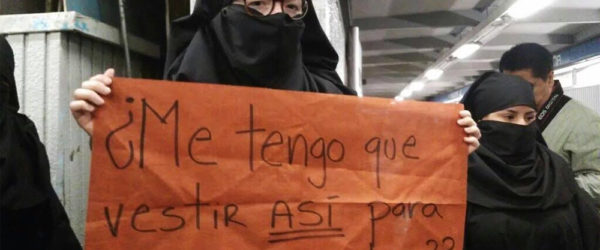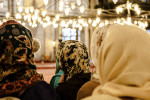Growing up in Mexico, neither hijabs nor niqabs were a thing. On paper, we are still a very Catholic country with 83% of the population being identified as such in the national census. Muslims in Mexico are concentrated among Lebanese-Mexican communities and southern Indigenous communities in Chiapas, Mexico. Broadly speaking, twenty years ago we were not a society that was overly concerned with Muslims and “their practices,” but 9/11 changed all that for many of us.
9/11 put Muslims on the mainstream media’s radar, and we were confronted with everything from the images of the Saudis involved in the attacks to the stories of “celebrating Muslims” post-attacks. At the time these images were framed in the media as those of the “barbaric other,” though there were more nuanced understandings which had a longer historical frame. Following the invasions of Afghanistan and Iraq, we saw images of wounded children and pictures of women wearing purple, blue or black garments that covered the whole body. Generally speaking, there was ambivalence about the coverage of these wars in the sense that U.S. occupations are rarely well-regarded in Mexico, particularly in middle and lower-class circles. Many Mexicans, especially those who were most affected by things like NAFTA and forced migration to the U.S., or who grew up attending public school systems, where socialist education was prominent, have a complex relationship with our Northern neighbours. Nonetheless, 9/11 socialized many of us into the idea of “freeing” Muslim women from violence and backwardness.
For a lot of us, the burqa became an immediate archetype of the “Muslim other.” In a country where women are socialized into particular types of femininity that often include knee-length skirts and high heels, the images of women in burqas represented a contrast. These differences did not take much to become a symbol of Muslim women’s oppression, as opposed to the “freedoms” enjoyed by Mexican women.
Tensions over the hijab, niqab and burqa have become more obvious in the past ten years, which have brought many immigrants and refugees to Mexico, many of whom came from Iraq, Pakistan, Libya, Somalia, Sudan, etc. Mexico defines itself as a liberal-secular democracy and a Catholic country. In such a context, Muslim women’s bodies were often represented a threat by virtue of their racial and cultural otherness and of their “insistence” on wearing things that “clash” with how mainstream women “choose” to dress.
When in Rome do as the Romans do, am I right?
We’re all familiar at this point with the stereotypes linked with the veil. Here at MMW we have written about this issue from a number of different angles. For example, we have discussed the stereotype of the “OppressedMuslimWoman” in relation to Malala, Iranian women and the stories of abused Afghan women. What defines these stories is a very particular narrative of agency and freedom as per Western, often white, understandings of what agency and freedom entail, which contrasts with the image of the Muslim woman in a veil.
What is interesting is that this narrative, with all its colonial and imperial connotations, has permeated the discourse in places like Mexico, a non-white, non-Western country. In many cases the narrative has been picked up by feminist groups, including FEMEN Mexico.
So why do I raise all this? Well, recently, Mexico, particularly central and Northern Mexico, has been identified as the one of the most dangerous countries for women across the world. The War on Drugs has had incredibly strong effects on the environment of violence, particularly against women, first because it has not been recognized as a “formal conflict” so little attention has been paid by international actors and global media outlets (unless it involves a white Westerner), but also because it has fed into a colonial system of impunity that seems to be beyond fixing at this point in time. Today, sexual violence is rampant in Mexico, and it is reflected not only in the high profile cases, but in the day to day situations. One of the places where sexual harassment is common is in Mexico City’s subway. The subway even has women and children-specific wagons, which is controversial. On the one hand, some people, including my dad for instance, are against them because it reinforces the idea that women can only be “safe” while segregated. On the other, many women, including me, feel that the space gives peace of mind to those who choose to ride in those wagons.
The two strands I have traced (discourses around the OppressedMuslimWoman and the rise of sexual harassment and rape against women in Mexico) are coming together in interesting ways. Last week a group of women identified as GIRE (Information Group on Pro-Choice Information) protested sexual violence and harassment in Mexico at a metro station and some wagons. These women dressed in black abayas and niqabs and carried signs that said “Do I have to dress like this for you to respect me?” They also used the hashtag #MiCuerponoesPublico (My body is not public), to spread the message in social media.
When a friend of mine posted the news in my timeline, I rolled my eyes. And I was not the only one… Muslim women in Mexico felt deeply offended by the use of the niqab (conflated with the burqa, usually) as a symbol of oppression. The organization of Muslim Women in the city issued a statement saying, “This women group’s actions does not represent us, and although we want them to be respected […] the wrongful use of the Islamic dress hurts us and contributes to the environment of Islamophobia.”
Feminist movements are not new to Mexico. Our feminist movements “formally” trace back to the 19th century. But in urban centres the feminisms that have predominated are those of the mestiza/urban women, the mainstream population in the country. These feminisms often combine elements of radical and Western white feminisms in a Latin American context and they should not be confused with Chicana feminisms. Similar to white feminisms, these feminisms have broadly disregarded the needs and opinions of indigenous and black women. Most recently, they have adopted the “OppressedMuslimWoman” narrative, while ignoring that Islamophobia is a real thing in Latin America.
These approaches are problematic for me in different ways. First of all, they are ignorant. Muslim feminists across the world have made efforts to get rid of the assumption that “modest clothing” prevents harassment or rape. Many Muslim women wear the hijab for religious reasons, not because they think it will make them any safer. The blame is with the people who harass or rape, not with the women experiencing the violence. These approaches also ignore that Mexican society is deeply hypocritical in regards to the policing of women’s bodies. Rape cuts across all segments of the population, regardless of dress, even when we are taught that “modest and feminine dress” (Mexican style) will make us “respectable” enough not to be attacked. How modest is “too modest” is up for discussion.
Furthermore, the way the protest was carried out shows an incredibly lack of awareness of Mexico’s social paradigm. Mexico has always been diverse. And although Muslims remain a very small minority, the lack of sensitivity towards issues of Islamophobia, speaks to one of the problems of mestiza feminisms…they tend to also align themselves with a secular ideology that resembles that of France’s government. Hence, the narrative of agency and freedom is one that defines itself against “the other.”
But most importantly, there is no need to use the veil as a symbol of oppression, or to define ourselves against the “OppressedMuslimWoman”. Why not tap into the history of Mexican feminism instead? For example, as problematic as she is for the cultural appropriation of Zapotec culture, there is Frida Khalo, who was a pioneer of socialist-feminisms and fought social conventions on sex and gender in different ways. Mexican youth are doing so much in ways that are culturally relevant, youth-centered and do not rely on ideas of “the other” (here, here and here). Perhaps renewed efforts to challenge lateral violence within feminist movements are needed. “Othering” should not and cannot be the source of feminist struggles if we are to truly address violence against women while recognizing the particular and intersecting ways in which minorities, including Indigenous, black and Muslim women, experience violence.




